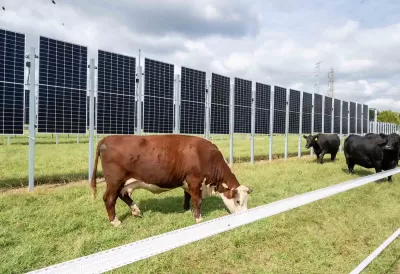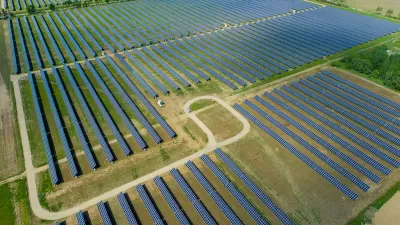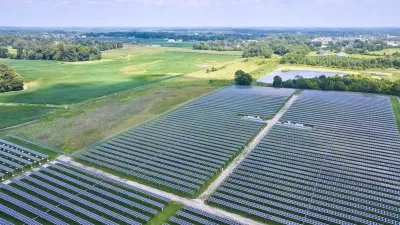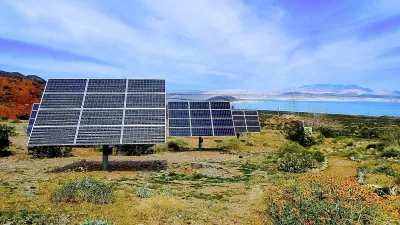A Rutgers University-New Brunswick demonstration farm will evaluate solar array designs to understand how they can best support grazing and agriculture on the same site.

A new research and demonstration project at Rutgers University-New Brunswick combining solar energy production with livestock grazing could help researchers understand how the design of solar installations can facilitate agriculture and ranching on the same sites to prevent the loss of productive farmland to solar farms.
As Kitta MacPherson explains in a Rutgers press release, “The installation on College Farm Road on the George H. Cook campus will allow researchers to investigate how the design affects grazing strategies for beef cattle and ease of hay harvesting. Scientists also will assess whether certain crops fare better in New Jersey’s climate using an agrivoltaics system, compared with crops produced in other regions of the United States employing agrivoltaics.”
Unlike many solar arrays, the Rutgers installation spaces panels far enough apart to let grass grow between rows and provide enough space for cows to graze. According to Rutgers Agrivoltaic Program Lead David Specca, “Our approach emphasizes food production and considers the generated electricity as a low-risk and supplemental income for farmers.” The project could help New Jersey get closer to reaching its renewable energy goals while preserving farmland.
Earlier this year, Ohio state officials gave the go-ahead to a 6,000-acre agrivoltaic project that will combine solar energy production with sheep ranching and agriculture.
FULL STORY: Cows and Solar Panels? In a New Jersey First, Project Melds Farming With Electricity Generation

Alabama: Trump Terminates Settlements for Black Communities Harmed By Raw Sewage
Trump deemed the landmark civil rights agreement “illegal DEI and environmental justice policy.”

Planetizen Federal Action Tracker
A weekly monitor of how Trump’s orders and actions are impacting planners and planning in America.

The 120 Year Old Tiny Home Villages That Sheltered San Francisco’s Earthquake Refugees
More than a century ago, San Francisco mobilized to house thousands of residents displaced by the 1906 earthquake. Could their strategy offer a model for the present?

In Both Crashes and Crime, Public Transportation is Far Safer than Driving
Contrary to popular assumptions, public transportation has far lower crash and crime rates than automobile travel. For safer communities, improve and encourage transit travel.

Report: Zoning Reforms Should Complement Nashville’s Ambitious Transit Plan
Without reform, restrictive zoning codes will limit the impact of the city’s planned transit expansion and could exclude some of the residents who depend on transit the most.

Judge Orders Release of Frozen IRA, IIJA Funding
The decision is a victory for environmental groups who charged that freezing funds for critical infrastructure and disaster response programs caused “real and irreparable harm” to communities.
Urban Design for Planners 1: Software Tools
This six-course series explores essential urban design concepts using open source software and equips planners with the tools they need to participate fully in the urban design process.
Planning for Universal Design
Learn the tools for implementing Universal Design in planning regulations.
Clanton & Associates, Inc.
Jessamine County Fiscal Court
Institute for Housing and Urban Development Studies (IHS)
City of Grandview
Harvard GSD Executive Education
Toledo-Lucas County Plan Commissions
Salt Lake City
NYU Wagner Graduate School of Public Service





























